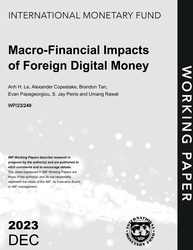
Macro-Financial Impacts of Foreign Digital Money
Macro-Financial Impacts of Foreign Digital Money
READ MORE...
Volume/Issue:
Volume 2023
Issue 249
Publication date: December 2023
ISBN: 9798400261107
$20.00
Add to Cart by clicking price of the language and format you'd like to purchase
Available Languages and Formats
| English |
Prices in red indicate formats that are not yet available but are forthcoming.
Topics covered in this book
This title contains information about the following subjects.
Click on a subject if you would like to see other titles with the same subjects.
Economics- Macroeconomics , Money and Monetary Policy , Economics / General , Cryptocurrency , Open Economy , Financial Frictions , Optimal Policy , monetary policy transmission , liquidity services , banking sector stress , stablecoin price , stablecoin issuer , Central Bank digital currencies , Currencies , Bonds , Global
Also of interest
Summary
We develop a two-country New Keynesian model with endogenous currency substitution and financial frictions to examine the impact on a small developing economy of a stablecoin issued in a large foreign economy. The stablecoin provides households in the domestic economy with liquidity services and an additional hedge against domestic inflation. Its introduction amplifies currency substitution, reducing bank intermediation and weakening monetary policy transmission, worsening the impacts of recessionary shocks and increasing banking sector stress. Capital controls raise stablecoin adoption as a means of circumvention, increasing exposure to spillovers from foreign shocks. Unlike a domestic CBDC, a ban on stablecoin payments can alleviate these effects.
Copyright © 2010 - 2026
Powered by:
AIDC



